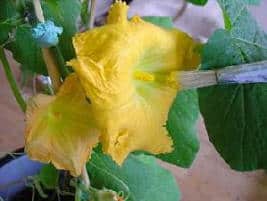Birds do it! Bees do it! And yes, your hydroponic tomatoes do it too…We’re talking about fertilization here… reproduction… the transfer of pollen from the male to female parts of the plant, so flowering and fruiting can result. The plant pollination process is different in the hydroponic garden than it is in your outdoor garden.
Our Beginner’s Guide To Hydroponics is on sale for a short time. Check it out!

Plant Pollination Process – How (and when) to Lend a Helping Hand
Outdoors, crops are naturally and easily pollinated by bees and the wind. But indoor gardens (greenhouses and hydroponics) sometimes need a little help to complete the plant pollination process.
No Problem!
The good news is: there really are few vegetables that need to be pollinated by hand. Let’s keep this simple!
You can break your veggies down into three different groups:
- Leaf and root crops – Pollination is not important at all for these, so don’t worry about it: (leafy greens, spinach, cabbage, herbs) and roots (beets, carrots, radishes)
- Self-pollinating – Each flower contains all the necessary parts to make a fruit; hand pollination is almost never necessary for this group: tomatoes, peppers, eggplants, all beans and peas, greenhouse variety cucumbers)
- Cross-pollinating – These plants sprout male and female flowers, which are different. The male flower will have pollen-laden stamens and the female flower will usually have what looks like the tiny bud of a vegetable at the base. Cross pollinators usually need a hand or artificial pollination if they are not grown outdoors: (melons, squash, most cucumbers)
When to pollinate
If you follow our advice to always keep an oscillating fan gently circulating air in your garden, chances are, pollination will take place without any help at all.
When your fruiting crops sprout flowers and the petals curl back, it is time for you to lend a hand. You want to do the pollen transfer every other day for 4-6 days. Do this at midday, when the humidity is lowest.
This increases the chances of success with a plant pollination process.
How to hand pollinate
There are two ways you can artificially pollinate your crops:
1. For self-pollinators, you usually don’t need to help, but if they just don’t want to set fruit, you will need to do one of these to lend a hand:
- Gently flick the stems near the flowers with your finger.
- Hold an electric toothbrush on the stem near the flowers for a few seconds.
- Brush inside each flower, making sure the pollen gets down into the pistil (middle part) of the flower.
2. For cross-pollinators, you will have to transfer pollen from the male flowers to the female, by hand.
- Get a cheap, small watercolor brush, or use a q-tip. The male is just an ordinary flower. The female flower is at the end of a tiny squash or cuke, you have to look carefully. Brush up some of the pollen from the male flower and transfer it to the pistil on a female flower.

Amazing! You are now a practicing botanist. And what a great lesson in nature for the kids! (Hydroponics makes a super science fair project).
Still no fruit?
If your plant still doesn’t set fruit in a few days, (tiny fruits either do not appear or they shrivel and dry up) then something else might be wrong. Stress can cause your plants to conserve energy and forget about bearing fruit.
What kind of stress?
Inadequate moisture, lack of light, and nutrient deficiencies can cause fruit-drop. Another common cause is mid-summer heatwave. High day
and night-time temperatures will stress the plant, and the fruit may abort as a result.
Don’t panic! If you cool off the grow room, you will see new females appear and successful pollination should then occur.

See the tiny cukes under the flowers? It means we’ve successfully pollinated them.




Best Grow Room Temperature And Humidity
Thursday 14th of October 2021
[…] Very high or low humidity makes pollination difficult (a very important process addressed fully here: Plant Pollination). […]
Troubleshooting Hydroponic Plant Problems
Thursday 14th of October 2021
[…] Blossoms drop: climate problems (too hot, improper light, too humid or too dry), as well as overwatering. Make sure there is a 10° temp drop at night when the lights go out. Learn more about Blossoms not getting pollinated. […]
Best Hydroponic Plants - What To Grow
Thursday 14th of October 2021
[…] At first anyway, try to stick to the bush, self-pollinating, and special “greenhouse” varieties of vegetables. We list some “hydroponically-friendly” varieties to get you started on our Veggies Page. And if you do ever need help with pollinating your indoor plants, there’s always the pollination page. […]
Growing Hydroponic Tomatoes
Thursday 14th of October 2021
[…] With a gently oscillating fan going, chances are very good that you will not have to do any hand pollination. I have never had to lend a hand to my tomatoes in this process. But if you find the fruits are not setting, read the pollination page. […]
3 Ways To Celebrate "Learn About Butterflies Day" On March 14
Monday 8th of March 2021
[…] their stunning appearance, butterflies have much to offer. Perhaps the best-known benefit is that butterflies pollinate a wide range of plants, from wildflowers to fruit and vegetable […]